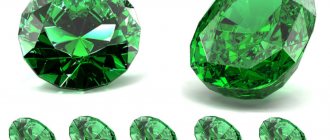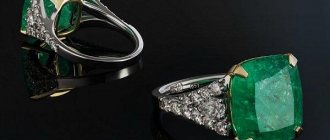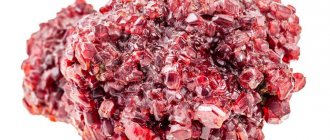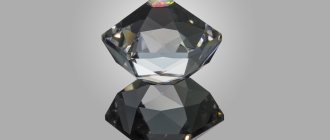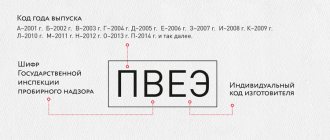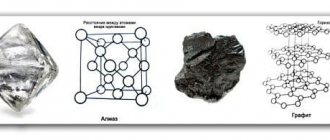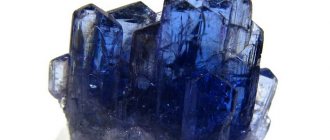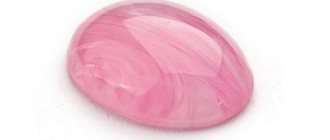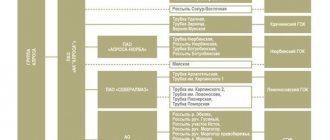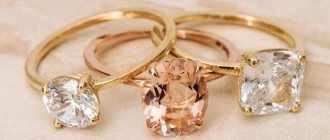Emerald is a beautiful and popular stone. In Russia it is sold at prices ranging from 22,555 to 547,740 rubles per carat .
Emerald is a precious stone. It is used to decorate rings, bracelets, pendants, flowerpots and other products. Such crystals are mined in India, Zaire, Russia, Colombia, Zimbabwe, Madagascar, Pakistan, Afghanistan, and Brazil.
Emeralds are colored green . May have a gray or blue tint. Their color saturation varies widely. The gem is harder than quartz and softer than sapphire and ruby.
You may need to buy an emerald in the following cases:
- You need to make jewelry with a precious stone for yourself or as a gift for someone.
- You need to invest your money profitably.
- I would like to make an original gift.
Criteria for determining quality
To choose the best stone, you need to know how to check its quality. This can be done by specialists with knowledge in this field. The check is performed using professional equipment. But there are basic characteristics that determine the value of an emerald, knowledge of which will help everyone when choosing a stone.
What criteria are considered decisive?
- Color.
- Transparency.
- Origin.
- Cut.
- Weight and size.
Knowledge of all these characteristics will be useful when purchasing products with emeralds.
Transparency and purity of stones
When choosing jewelry, you should pay attention to purity, which also affects the quality of the emerald, although this is not the dominant characteristic. Purity, or transparency, can be determined visually, without the use of magnifying devices.
If the stone being tested has the same characteristics (density, size, color) compared to others, then it is better to choose the one that has greater transparency. The value of the turbid mineral is much lower.
In nature, it is almost impossible to find emerald minerals that are ideal in purity without any flaws (this is due to the methods of their extraction). The presence of visual defects indicates a real, not fake, emerald. But there are inclusions that create a unique pattern on the surface of the gem, and jewelry made from it is unique, and their cost is many times higher than jewelry made from pure emerald.
Emerald Clarity Chart
| By cut | ||||
| Emeralds with cut | Cabochon | |||
| G1 | G2 | G3 | K1 | K2 |
| The stones are clean or have almost imperceptible flaws: small cracks, stripes, pinpoint inclusions in different parts of the mineral. There is glitter and play | Stones with minor flaws: small cracks, stripes, combined with point inclusions of other rocks, which create a thickening and network in certain parts of the mineral | Stones with flaws: cracks, stripes, with pinpoint inclusions of other rocks located throughout all parts of the stone, with separate areas of cloudiness, in which sometimes there is no shine or play | Flaws from cracks, stripes, inclusions, with an area of turbidity in different parts of the rock. At the same time, the stones are transparent and translucent with the presence of shine and play. | Large flaws with an extensive network of cracks, stripes, interspersed with cloudy areas inside the stone. At the same time, the stones are transparent and translucent with a partial loss of shine and play. |
| By color | ||||
| 1 | 2 | 3 | 4 | 5 |
| Dark green | Normal green | Medium green | Light green | Pale green |
An emerald whose carat weight reaches 5 can be cut only if its color corresponds to the first three groups.
Description of emerald and its physical properties
Emerald has another name - “green ice” because of its amazing shine and rich color. This variety of beryl is included in the group of 1st order gemstones. In addition to the above mineral, emerald may contain chromium, vanadium or iron oxide. It is thanks to these impurities that the gem received its rich grassy green color.
Mineralogists have identified the following properties of emerald:
- Formula – Be3Al2Si6O18.
- Colors are green and greenish-yellow.
- The color of the mineral in powder is white.
- The shine is glassy.
- The degree of transparency is high or medium.
- Mohs hardness – from 7.5 to 8.
- The fracture is uneven, conchoidal.
- Density level – from 2.69 to 2.78 g/cm³.
Like some precious minerals, emerald is hard but fragile.
Emerald color
When assessing the color of an emerald, you need to take into account its tone, saturation, and lightness. The shade of the crystal varies from yellowish-green to blue-green, but the main tone is green. Dark green stones are found in nature.
Even uncut crystals have uneven color. Some stones have edges that are brighter than the base. In other gems, the color intensity changes zonally: lighter longitudinal stripes and a bright core or alternating light and dark zones across. The hue of a brightly colored stone can change from yellowish to bluish or greenish when it is rotated. This property is called dichroism.
https://youtu.be/rU6_MWRpia0
Density
Emerald, as emerald is also called, has different densities. This indicator depends on the type and deposit of the crystal. The average density is 2.73 g/cm³. For example, the density of Siberian and Colombian gems is 2.72 g/cm³, Brazilian – 2.67 g/cm³, African – 2.77 g/cm³.
This indicator depends on the impurities - cesium and rubidium. The higher the content of these valuable metals, the higher the density of the emerald. Nuggets of bright green color contain the most rubidium and cesium. According to geologists, such stone becomes harder and harder over time.
Purity
Transparency or cleanliness can be determined without the presence of special instruments if a person has normal visual acuity. In nature, there are practically no gems without defects; minor damage is even proof that this is a real emerald.
Be sure to see: Types, colors and magical properties of garnet stone
Classification of emeralds by purity:
- G1 – stones that are clean or have minor flaws (cracks, stripes, inclusions). There is shine and play of color.
- G2 – minor defects, inclusions of other rocks, small areas of thickening of color.
- G1 cabochons have noticeable flaws, inclusions of other types are localized on different parts of the crystal, there are areas of cloudiness without shine, as well as plays of light.
- G2 cabochons – pronounced defects, noticeable cracks, stripes, inclusions, cloudy areas. The stone has partially lost its shine, as well as its play.
Attention! This is an important criterion that is taken into account when choosing a quality emerald.
Cut
Jewelers always carefully examine a raw emerald under a magnifying glass to look for any imperfections. If there are few defects, then the craftsmen use emerald cutting, which makes the gem simply amazing. After processing, the crystal has a rectangular shape with rounded corners. However, other cutting methods are also used.
If a nugget has many flaws, cracks, stripes, inclusions, or the play of light is difficult, then it is processed in a special way. A cabochon is made from such defective crystals. After grinding, a rounded translucent stone without edges is obtained.
Resistance to external influences
According to mineralogists, emerald is highly resistant to acids and other reagents. However, when heated to temperatures above 700°, it begins to discolor. In addition, despite the high level of hardness, the gem is quite fragile, so you need to be careful with it and not drop it.
View this post on Instagram
Interesting ❌ emerald The main mining of emeralds in Colombia is the Muzo region. Colombian deposits are famous throughout the world for their emeralds. They were developed even before the conquest of America by the Spaniards, and in the second half of the 16th century, the emerald mines of Muzo came under the jurisdiction of the Spanish colonialists. But even after the formal conquest of Muzo, the Indians repeatedly rebelled and attacked the emerald mines that were in the possession of the Spaniards. In its entire four-hundred-year history, this area has never been free from war. And today, emerald mining in Colombia is a dangerous and often thankless task. More than 85 percent of the emeralds mined in Colombia are smuggled out of the country. For many years, a criminal international syndicate has been operating in this country, which has completely monopolized the sale of emeralds mined by local vaquero miners in countless mines and pits. The entire smuggling business system is based on the deception of the vaqueros. The next rung of the smuggling ladder after the vaqueros is made up of resellers, locally called “esmeraldos,” who supply emeralds bought for next to nothing from miners to Bogotá. This most dangerous level of the emerald business is monopolized by several “families” who connect the emerald repurchase centers in the cities of Muzo and Peña Blanca with the places of secret meetings of resellers with representatives of the next level of the smuggling ladder, transporting emeralds abroad. 1. Deep inside the Colombian emerald mines, a worker searches for signs of the gemstone after a dynamite blast loosens the rock. The mine, located in Muzo, is one of the three largest emerald mines in the country. Many valuable stones are mined here. 2. Twenty years ago, Muzo was at the center of the conflict that raged in Colombia. Today in the mountains above the city there is a sign that reads "Paz: Dios ve todo" (Peace: God sees everything). However, the emerald trade remains dangerous, largely unregulated and highly competitive.
A post shared by Jewelry ? and stones? (@ov.jewelry) on Nov 8, 2018 at 10:58am PST
Emerald cost per carat - table
| Emerald quality/presence of impurities | Cost per carat (USD) |
| Excellent quality, almost no impurities, rich color | 5000-8500 |
| Good quality, impurities are invisible to the naked eye | 2300-5500 |
| Noticeable impurities in the stone | 650-2700 |
| Poor quality emerald, noticeable impurities, dull stones | 350-375 |
Types of diamonds and their costs
Types of precious minerals vary in shades . The color differences between stones are due to the presence of certain impurities or their absence. Diamonds that are expensive are those that do not contain a large amount of impurities and, for this reason, have transparency and a whitish tint. Of course, such diamonds also contain a certain percentage of inclusions, but it is very small.
The rarest red and green diamonds containing chromium are quite expensive. For one carat of such luxury you need to pay about 250,000 dollars . Rare purple stones with inclusions of hydrogen, pink crystals with an admixture of manganese, as well as blue ones, including a mixture of aluminum and boron, are expensive.
The cheapest minerals are brown ones containing iron, which gives them their color. The yellow ones are a little more expensive than the brown ones and have lithium inclusions.
Color
Many people think that emerald is a green stone. This statement is only partly true, since minerals are colored in different shades of green. Color largely determines their cost. The more flawless the color, the higher the value of the gem.
The color characteristic includes several parameters.
Hue
The most common color of emeralds is green. But this tone is the main one, which in most cases is combined with additional shades. Most often, yellow or blue shades join the dominant color. The overall tone of the entire stone depends on the secondary color.
Yellowness gives the mineral warmth, and blue gives it a cold tint. The color and purity of emerald are interrelated concepts. The purity of an emerald is determined by the presence of green colors in it. The presence of yellow, red or blue undertones in the mineral indicates that it belongs to different types of beryl.
Consumer demand for jewelry of different colors varies depending on fashion trends, but the interest in emeralds of the highest purity remains unchanged at all times.
Saturation and Hue
These are the defining features of color depth. Shallowly saturated stones have a grayish color and are not suitable for jewelry. Their place is among collectibles. High color density gives the mineral a dark, almost black color; a stone of this color is of increased interest to jewelry makers. But the most optimal in terms of value is considered to be saturation, which gives the stone a general background with the traditional green color.
The color scheme can vary from light to dark tones. Stones with low saturation, pale green tones are not valued very highly - they can cost only a few dollars per 1 carat. Excessive color saturation is in greater demand than light shades. But minerals of the purest color are truly precious (this is evidenced by the readings of the emerald tonality scale, the value of which should not exceed 70%). They are valued more expensive than others.
Varieties of emeralds
Depending on the deposit, emerald stone can be of the following types:
- Colombian. This is a variety of emerald that contains an admixture of fluorite and calcite with gas bubbles and minor inclusions. Such crystals are considered the most valuable, as they have a uniform structure and rich color.
- Ural. Gems of intense green color with a high content of iron and chromium.
- Brazilian. The nuggets have a grayish-brown tint due to the presence of vanadium in the composition.
- Zambian. The bluish crystals contain iron.
- Zimbabwean. The stones have a deep green color due to the presence of tremolite.
This is interesting! In Southern Yakutia, chrome diopside stone is mined, which in appearance and properties resembles an emerald. In honor of the deposit it is called the Yakut emerald.
Famous deposits
The most valuable specimens are mined in Colombia. They have virtually no defects; minor inclusions of calcite, fluorite, liquid or air are acceptable. They have a rich color and unique shine. These are the highest quality and most expensive emeralds.
Ural nuggets of extraordinary beauty are valued all over the world for their bright color (slightly lighter than malachite) and purity. The largest supplier of emeralds is the Ural Gem Company. Crystals are sold in their natural, unprocessed form.
Be sure to look: Classification, colors, types and photos of precious stones
Stones mined in Brazil are slightly lighter than Colombian ones and are quite clean. In Zambia (Kagem mines) high quality gemstones are mined. Also, deposits of “green ice” are located in Egypt, Afghanistan, the USA, etc.
Artificial emerald
Scientists have learned to create copies of emeralds in the laboratory. A crystal grown with the help of human efforts is superior to natural stone in color saturation, strength, and purity. Synthetic gems look simply amazing.
Nanoemerald is grown in a laboratory using emerald powder and various chemicals that are dissolved in water and exposed to high temperatures. Experts observe how the crystals grow and try to create optimal conditions for their maturation. A medium-sized nanoemerald grows in about 4 weeks.
However, despite the beauty and more affordable cost, real connoisseurs prefer natural stones
Difference between gold and diamond carats
To answer the question of how diamond carats differ from gold carats, it should be understood that these two definitions are used for different purposes:
The system for measuring the weight of gems and the gold content goes back to ancient times and is still used today. In the jewelry industry, carat scales with minimal error are used to determine weight in grams. To calculate carat content, there are many tables with the help of which even a person ignorant in this area can calculate the number of grams.
Characteristics and properties of diamonds
Diamond is a crystalline form of carbon . It is the hardest of the precious minerals and is characterized by high thermal conductivity. The color of the crystal can be transparent white, yellow, pink, blue, green and brown. Diamond mining began 3000 years ago in India. As a gem used to make jewelry, crystal became famous in medieval France. Currently, the largest diamond exporters are Russia, India, Africa, Canada and Brazil.
A diamond is a cut diamond of a special shape that emphasizes the natural shine of the stone. The diamond reaches private buyers in this form.
Principles for determining cost
In world jewelry markets, the cost of an emerald is measured in US dollars per carat (0.2 grams). The larger the crystal size, the more expensive it can be sold.
However, this is not the main evaluation parameter. Connoisseurs of this amazing stone pay close attention not so much to the size as to the uniformity and richness of color. Dark green gems with a bluish tint are valued in the range from 5 to 8.5 thousand US dollars per 1 carat.
Commercial stones used in the production of conventional jewelry cost $350-375 per carat. Such emeralds are valued significantly lower due to their light green color, as well as natural defects that reduce the level of transparency.
Average prices for raw and uncut minerals of various qualities are given in the table:
As the size increases, a cut and untreated emerald increases in value significantly. Weighing 3 carats, its cost is comparable to the price of diamonds of the same quality, and a green mineral weighing 5 carats is valued more expensive than a diamond.
In 2001, at a Christie's auction, an unknown buyer purchased an emerald weighing 217.8 carats for $2.2 million, and the price of 1 carat was more than $10,100.
Pricing factors
The cost of a gemstone may vary. The price of emerald is influenced by the following factors:
- Weight.
- Color, its uniformity, saturation.
- Size.
- Fragility.
- Degree of improvement.
- Presence of defects.
- Degree of transparency.
- Cut.
- Quality.
- Place of sale.
Smaller pieces may cost less than diamonds, while larger options sell for more than diamonds.
Approximate prices
Approximate cost of precious stones depending on color:
- Dark green with a bluish tint - 322,200-547,740 rubles per carat.
- Light green - from 22,555 to 24,165 rubles per carat.
Approximate prices for gems depending on their quality are shown in the table.
| Quality | Cost in rubles per carat |
| Excellent | 322200-547740 |
| Very good | 148215-354420 |
| good | 42015-174000 |
| Low | 22555-24165 |
How much does an emerald cost and how to distinguish it from a fake?
The emerald, the favorite of Queen Cleopatra, is one of the most valuable stones in the world. Moreover, its cost can range from two to hundreds of thousands of rubles per carat. This is due to the fact that the mined gems differ strikingly from each other in quality: in some countries they find magnificent transparent nuggets, while in others they find pale and “dirty” stones of low quality.
In this article we look at the following issues:
- how the quality of emeralds is assessed;
- what determines their price;
- how to distinguish a natural nugget from an artificial or fake one.
What affects the cost of emerald
It is quite difficult to calculate the exact cost of an emerald; gemstone experts must evaluate the stones. But it is possible to determine trends in pricing, indicate factors influencing the cost, and name approximate prices per carat without special verification - it is enough to know the laws of the jewelry market.
The cost of almost any gems, including emerald, is determined by the sum of the following characteristics:
- the region in which the stone was mined;
- purity of the gem;
- transparency of the stone;
- type and quality of cut;
- mass of the mineral after cutting;
- color saturation;
- expert opinion on the quality and authenticity of the stone.
The place where the emerald was mined affects the cost of the stone primarily because the region of origin of the gems determines a huge part of its characteristics. Thus, Colombian emeralds are considered one of the purest, with a minimum amount of impurities - these stones are quite transparent, and they have almost no chips or cracks.
Competing in price with Colombian emeralds are stones from Zambique, Africa. Green nuggets were discovered here only at the beginning of this millennium, but this African state has already earned the title of one of the leaders in emerald mining. Perfectly transparent and bright green Zambian stones are one of the favorites among jewelers.
The third large deposit of emeralds, from where the highest quality stones are supplied to the world market, is the Malyshevsky mine in the Urals. The gems mined here are often of gigantic size; moreover, they delight the eye with an infinitely rich green color, a moderate amount of impurities and a smooth surface. Light and completely transparent specimens are often found.
The purity and transparency of an emerald can make it tens of times more expensive than a diamond, since stones without inclusions (impurities) are not so common in the world. These characteristics may be more important than the country of origin of the crystal, since the purer the gem, the rarer and more expensive it is considered.
The quality and type of cut determine the expression of light in the stone and its weight: if the stone has undergone moderate processing (for example, “emerald cut”), then it will have more carats, therefore it will be more expensive. Although complex and fancy types of cuts can also increase the value of a gem, revealing its unexpected properties and depth. High-quality cut and rare specimens can be valued on the world market at $20,000 per carat (0.2 grams).
As for saturation , the “thickness” of the shade plays a role here: the lightest stones are cheaper, the darkest ones are more expensive. Both have advantages, although an example of quality is a pure emerald of rich green color - this will cost about 120,000 rubles. per carat
Finally, the conclusion of an expert from a gemological laboratory is a factor that determines the degree of confidence of buyers in jewelry with a stone. Among the authorities in evaluating stones are the US Association of Gemologists or the Gemological Center of Moscow State University. M.V. Lomonosov.
One of the most budget-friendly options is artificial emeralds. Their price is around 1,300 rubles. per carat
Russian classification of emeralds
Russia has its own system for assessing the quality of gems. According to her standards, there are 5 color groups of emerald :
- dark green;
- medium-dark green;
- medium green;
- medium light green;
- light green.
The closer an emerald is to group 5, the more its value decreases. Except when the stones are perfectly clean.
The purity of emeralds in Russia is assessed in 3 categories:
- transparent, almost without inclusions (impurities) - the most expensive;
- transparent with a small number of inclusions and cracks;
- with a large number of inclusions, internal opacities and cracks - the cheapest.
As for estimating mass , emeralds are divided into:
- Small – up to 0.49 carats;
- Medium – from 0.5 to 1 carat;
- Large – from 1 to 10 carats;
- Very large - from 10 carats.
Before purchasing expensive jewelry with colored stones, it is useful to understand the weight of gems of a certain size and cut.
Matching weight and size
In any jewelry store you will find a table of the relationship between the shapes, weights and sizes of precious stones. Below we present the most popular options:
- A 1.16 carat round cut emerald will measure 6.5mm;
- 1 carat oval cut – 8x6 mm;
- 0.90 carat emerald cut – 7x5 mm;
- 1.05 carat pear-shaped – 8x5 mm;
- 1.10 carat marquise cut – 10x5 mm.
The larger the emerald and the more complex its cut, the more expensive it will be. This applies to stones of the highest quality, because the cut reveals the depth of the gem and, in the presence of excessive impurities, a large number of facets will only highlight the flaws of the emerald. These emeralds are best suited for a cabochon cut.
What is sold as emeralds
The high demand for emerald among jewelry lovers encourages scammers and unscrupulous sellers to create fakes and imitations of this noble gem. Recently, the industrial creation of emeralds has been gaining momentum, in which the natural conditions for the formation of stones are imitated. As a result, crystals appear that are identical in chemical composition to natural ones, but still have a lot of differences.
Imitation emeralds
Fraudsters often pass off one stone after another. Under the guise of an emerald, it is proposed to buy cheaper gems. The list of minerals similar in shades and other characteristics to noble emerald is quite large. For example, for simulations they use:
Demantoid is a rare green stone that can surpass emerald in value. For fakes, of course, demantoids of lower quality are used.
Fluorite - some types of this mineral are similar in appearance to emerald, although fluorites are much softer and therefore have a weak shine.
Tourmaline is a type of stone from Tanzania that is high in chromium, which gives it its green color, and is incredibly similar to emeralds. But an experienced jeweler will quickly spot the differences, since tourmaline has a higher level of light refraction than emerald.
Chrome diopside is a stone so similar to an emerald that without a special light analyzer, even experts can confuse it with an emerald.
Artificial emeralds
When growing artificial emeralds, a hydrothermal method is used, which recreates conditions similar to those that occurred in the bowels of the earth millions of years ago, when natural gems were formed.
Such stones are synthesized in laboratories in just a couple of months, bypassing the long and complex process of birth in the bowels of the earth. Chemically, such stones are identical to natural ones, but there are physical differences.
Natural gems have many different impurities - particles of other stones, gas and liquid bubbles. There are very few impurities in the composition of grown emeralds, which for an experienced expert is a signal of the laboratory origin of the stones.
In addition, synthetic emeralds, unlike natural ones, will forever retain the imprint of an industrial machine. Unfortunately, they have no individual history or investment value.
Doublets and triplets
This is one of the crudest types of emerald counterfeiting. In the process of creating doublets, craftsmen glue two parts of beryl with a green layer. As a result, a solid emerald-colored stone is formed from a transparent gem. Triplets are the same as gluing, but in this case three parts are connected to each other at once.
Natural emeralds can also be glued into one stone, but the quality of monolithic gluing still leaves much to be desired. Also, in the process of creating doublets and triplets, parts of cubic zirconia, glass and other materials that are used in jewelry can be connected.
Such products are quite inexpensive, so the low cost of emerald should immediately alert you.
Cost of emeralds per carat
Approximate prices of emeralds can be determined depending on their color or quality.
Price depending on color:
- Dark green ≈ 550,000 rub. per carat
- Light green ≈ 25,000 rub. per carat
Depending on the quality, emeralds can cost:
- About 25,000 rub. per carat for “low” quality;
- About 170,000 rub. per carat for “good” quality;
- About 350,000 rub. per carat with “average” quality;
- About 550,000 rub. per carat with “excellent” quality.
It is worth noting that unique gem samples have special pricing that is not subject to an average estimate. The rarest, unique specimens can reach a cost of several million rubles per carat.
Buying an emerald is a significant event. The stone can accompany you for many years, become your talisman and family heirloom. To do this, you should take a close look at the jewelry before purchasing it in order to choose a high-quality and real gem.
Unique natural emeralds from the world's best deposits adorn products from Maxim Demidov, which you can buy in our catalog.
Upgrading of low quality minerals
The jewelry industry, which provides middle-class people with jewelry, practically does not use high-quality minerals. Gems with numerous defects that have undergone the process of refining and cutting are more often sold.
Cedar oil is traditionally used to fill the voids and cracks that natural large crystals are rich in. It does not change the color of the stone, giving it additional transparency and shine.
Small gems up to 0.49 ct in size are often refined using epoxy resin or artificial polymers, which are matched to the color of the natural stone. Due to its small size, it is impossible to detect such inclusions with the naked eye, and emerald does not differ in appearance from non-refined one.
The higher the degree of refinement, the lower its original quality and the lower the price at which the crystal can be sold in a jewelry store.
Cut, weight and size
High-quality cutting and polishing can determine the price of stones. This is due to the fact that excellent processing will only be possible on stones with high performance. Correct polishing will improve the characteristics of the emerald, emphasizing its radiance, beauty and nobility.
Regarding the weight, let’s immediately clarify that 1 carat is 0.2 grams. The higher the carat value of the emerald, the more expensive it is. This expression is true with one caveat. This is true when stones of different weights have the same performance in other characteristics.
The selected stone should be examined with a magnifying glass to see any imperfections in the cut. To give the shape of a mineral, emerald cuts are often used. It looks like a rectangle with rounded corners. Jewelry processed in this way looks simply stunning, but other types of cutting are also used.
If an emerald contains a significant number of defects or large areas of other inclusions, which impedes the play of light, then a cabochon is made from it - a round shape without edges.
If the flaws are too obvious (for example, through cracking), which threatens to break the stones, they are simply not used.
Magical properties of emerald
According to people associated with esoteric teachings, if you meditate for a long time while looking at an emerald, you can see the future. It is not without reason that the famous tablets of Hermes, on which all the wisdom of the world is written, were made of solid emerald. It is believed that it protects the human soul while traveling through the Astral, and helps mediums quickly contact the souls of the dead. There are also a number of other magical properties of this precious mineral.
Emerald fights the bad inclinations of its owner: laziness, theft, debauchery, deceit. If a person continues to indulge in vices, then the stone, instead of helping, may begin to harm its owner. And when his strength is depleted, the emerald will split.
If the stone is in the house, then over time its energy is cleared of negativity. The same applies to the person who constantly wears the jewelry with him.
Advertising - Continued below
What is interesting about hydrothermal emerald?
Emeralds
Emerald, like many precious stones, has already been synthesized in official laboratories. The price of a hydrothermal stone will be small compared to a natural mineral - on average about 1300-1500 rubles per carat.
In terms of chemical and physical properties, artificial stone is in no way inferior to that found in natural deposits. Laboratory conditions make it possible to obtain transparent stones of rich colors weighing 2 or more carats.
Artificial emeralds are widely used in creating jewelry. The low price allows you to create jewelry that is accessible to everyone.
The advantages of artificial hydrothermal minerals are not only an affordable price, but also an environmentally friendly approach to extraction. Synthesis of stones in the laboratory does not require penetration into rocks and the use of hard labor, only silence and careful attention to the mineral during growth.
Emerald deposits
Currently, the largest amount of all emeralds is mined in Colombia. Zambian emerald deposits also have a fairly high rate: about 20% of the total number of these minerals is mined here. And their quality is much better than Colombian emeralds.
The most famous, oldest and largest emerald deposit in Russia is the Ural emerald mines. Not only precious emeralds are mined here, but also alexandrite, apatite and other minerals.
Advertising - Continued below
How many grams in one carat
At the beginning of the 20th century, jewelers agreed on the exact number of grams in a carat. In 1907, they decided to equate the weight of one carat to 0.2 grams. However, not all countries agreed to convert the mass into carats, continuing to use their own values. The countries adopted a unified standard in the following sequence:
Following these states, other countries also decided to convert grams to carats. However, a 1 ct gem is a rare and expensive stone. Much more often you come across crystals with a smaller mass, not reaching 0.2 grams. But here, too, jewelers did not use standard measures and created their own unit - the point. It has been established that one ct (0.2 grams) is equal to 100 points.
Origin
The place of origin greatly affects the value of gemstones. Professionals can determine where emeralds are mined by color. Colombian have additional yellow tones, blue shades are present in Zambian gems.
Stones extracted from Colombian deposits are in high demand among buyers. But this indicator does not mean that the properties of emeralds from Colombia are superior to stones from Zambia. It's all about advertising here.
After extraction, the gems are processed to correct flaws and are brought to near perfection. It is extremely rare to find an emerald without flaws (cracks) in nature. If this happens, then its cost is incredibly high, since it is considered almost a pure emerald.
At affordable prices, emerald minerals with an impregnated defect are available for sale, which is not visually noticeable. But their beauty does not diminish from this. Craftsmen often use cedar oil as an impregnation.
Which zodiac signs suit emerald?
Robert Procop ring with diamonds and emerald weighing 23 carats
Who is suitable for emerald according to the horoscope? Gumun L.V. and Naumkina N.P. in their astrological encyclopedia indicate that among the favorites of the gemstone are Leo, Cancer, Aries, Pisces, Sagittarius. Taurus can also wear a green gem - it will also benefit them.
Regarding “contraindications,” astrologers agree that Scorpio is most likely to have conflicts with emerald. For everyone else, the stone will show neutral properties: neither much harm nor much help should be expected from it.
Kinds
Emeralds are classified according to their deposit:
- Colombian.
- Russian.
- Indian.
- Brazilian.
The best emeralds are those from Colombia. They are characterized by higher color saturation. Asian and Brazilian stones are painted in a light yellow-green tint and are fragile, so they are cheaper than Colombian ones.
Depending on the color, the following types of emeralds are available for sale:
- Dark green.
- Green with a bluish tint.
- Light green.
- Yellow-green.
- Green-gray.
The following types of emeralds are distinguished by quality:
- Low quality.
- In good shape.
- Very good quality.
- Excellent quality.
The stone can be unprocessed or faceted. The latter are more expensive.
You can buy gems in the following places:
- In a specialized company.
- At the pawnshop.
- In the online store.
- Based on an advertisement from a private individual.
Synthetic stones for the jewelry industry
Natural stones are expensive, which is why there are many artificial emeralds on the market. A synthetic gem is in no way inferior in appearance to a real one, has a larger size, but costs much less. Read more in the article “What are hydrothermal emeralds: types of synthetic stones.”
Unscrupulous sellers often take advantage of this and sell artificial emeralds under the guise of natural ones.
In a jewelry workshop, it is not difficult to detect falsification. It is enough to direct a concentrated beam of light from a halogen lamp and examine the stone through a special filter. Natural emerald glows pink or reddish, while the fake one remains green.
Another way to check quality is to immerse the jewelry in a container filled with washing powder or dishwashing liquid. The oil and other fillers will dissolve and the emerald will take on its natural color.
The healing properties of emerald
According to legend, it was in an emerald cup that the blood of Christ was collected, and subsequently, anyone who was given the honor of drinking from it was instantly cured of all diseases. This vessel is now known as the "Grail" or "Holy Grail".
The emerald stone can relieve the owner from headaches, nightmares and insomnia. Helps get rid of various types of psoriasis, infections and high fever. If you wear jewelry with emerald, it can enhance the effect of any treatment, and will also relieve the owner from night blindness, various gastrointestinal diseases and coughs.
It is believed that if this stone is placed in a container of water for at least an hour, the liquid will be cleared of harmful microbes and bacteria.
Advertising - Continued below
Matching weight and size
If you decide to purchase a piece of jewelry inlaid with large emeralds, then you need to have an approximate idea of what size gems of a particular weight should be, depending on the type of cut. For this purpose, special tables are used, which can be found in any self-respecting jewelry store.
A baguette and octagon-cut crystal weighing 1 carat has a size of about 7x6 mm, a 2-carat emerald is 8x7 mm, and a three-carat stone is 9x8 mm.
With other types of cuts, the size of the crystal varies greatly, but an oval 4 ct emerald has a size of about 11.5 by 9.5 mm.
Be sure to pay attention to the price list indicating the price of gems, by which you can easily determine what quality stones are in front of you. Remember that there are many synthetic crystals on sale, the price of which is approximately 2.5 times lower than low-quality natural emeralds.
Sources
- https://zolotoe-runo-sl.ru/dragocennye-kamni/skolko-stoit-karat-izumruda.html
- https://russam.ru/stati/o_juvelirnyh_izdelijah/p14998-stoimost_naturaljnogo_izumruda/
- https://stone-stream.ru/dragocennye/stoimost-izumruda-za-karat.html
- https://PulsKamnya.ru/dragotsennie/izumrudy/skolko-stoyat-2
